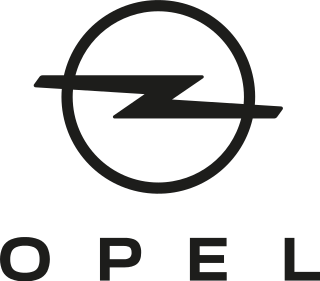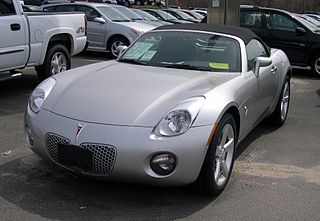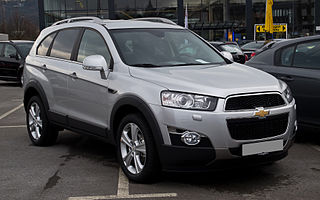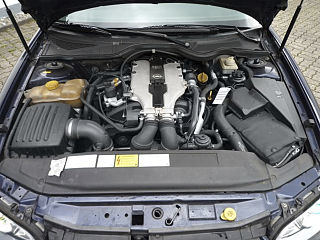
Opel Automobile GmbH, usually shortened to Opel, is a German automobile manufacturer which has been a subsidiary of Stellantis since 16 January 2021. It was owned by the American automaker General Motors from 1929 until 2017 and the PSA Group, a predecessor of Stellantis, from 2017 until 2021. Opel vehicles are sold in Britain under the Vauxhall brand. Some Opel vehicles were badge-engineered in Australia under the Holden brand until 2020 and in North America and China under the Buick, Saturn, and Cadillac brands.

Vauxhall Motors Limited is a British car company headquartered in Chalton, England. Vauxhall, along with its sister brand Opel, became a subsidiary of Stellantis in January 2021.

The Opel Astra is a compact car/small family car (C-segment) engineered and manufactured by the German automaker Opel since 1991, currently at its sixth generation. It was launched in September 1991 in hatchback, saloon, and station wagon forms. A sedan delivery/panel and a convertible also appeared in the early 1990s. These bodystyles were later followed by a coupé in 2004, the sporty Astra OPC appeared in 2005, the Twin Top retractable hardtop convertible replaced the soft top convertible in 2006, while the Caravan was rebadged Astra Sports Tourer from 2009 onwards.

The Opel Vectra is a mid-size car that was engineered and produced by the German automaker Opel from 1988 until 2008. The Vectra was also sold by the Vauxhall marque in the United Kingdom as the Vauxhall Cavalier from 1988 to 1995 and as the Vauxhall Vectra from 1995 to 2008, and it was also sold by Holden in Australia as the Holden Vectra, and by Chevrolet in Latin America as the Chevrolet Vectra.

The Vauxhall Cavalier is a large family car that was sold primarily in the UK by Vauxhall from 1975 to 1995. It was based on a succession of Opel designs throughout its production life, during which it was built in three incarnations. The first generation of Cavalier, launched in 1975 and produced until 1981, was based on the existing Opel Ascona and Opel Manta with a few minor visual differences.

The Opel Omega is an executive car engineered and manufactured by the German automaker Opel between 1986 and 2003. The first generation, the Omega A (1986–1993), superseded the Opel Rekord. It was voted European Car of the Year for 1987, and was available as a saloon or estate. The second generation, the Omega B, was manufactured from 1993 to 2003.

The Opel Ascona is a large family car that was produced by the German automaker Opel from 1970 to 1988. It was produced in three separate generations, beginning with rear-wheel-drive and ending up as a front-wheel drive J-car derivative.

The Opel Calibra is a coupe, engineered and produced by the German automaker Opel between 1989 and 1997. In the United Kingdom, where it remained on sale until 1999, it was marketed under the Vauxhall brand as the Vauxhall Calibra. It was also marketed as the Chevrolet Calibra in South America by Chevrolet, and the Holden Calibra in Australia and New Zealand by Holden.

The General MotorsJ platform, or J-body, is an automobile platform that was used by General Motors for compact cars from the 1982 to 2005 model years. The third generation of compact cars designed by GM, the J-body marked the introduction of front-wheel drive for its compact model lines, replacing the rear-wheel drive H platform. The J-body was marketed as a world car, with GM brands selling versions of the platform in North America, Europe, Australia, and Japan; in markets outside of North America, the model line was packaged as a mid-size car.

Delta is General Motors' compact front-wheel drive automobile and crossover SUV platform, a successor to the GM T platform; it also replaced GM J platform and the Z platform used by the Saturn S-Series. The platform debuted in the 2003 Saturn Ion. Vehicles of this platform generally carry the letter "A" in the fourth character of their VINs.

Kappa was General Motors' subcompact rear-wheel drive automobile platform for roadster applications. The architecture debuted in the 2006 Pontiac Solstice and 2007 Saturn Sky, and ended production in 2009. These vehicles generally have a "M" in the fourth digit of their VIN.

Epsilon is General Motors' mid-size front-wheel drive automobile platform. The architecture was developed by Opel, and debuted in the 2002 Opel Vectra and 2003 Saab 9-3. Since this platform falls squarely in the center of the worldwide automobile market, GM plans to produce a great many Epsilon vehicles with over a dozen variations. As of 2005, it was GM's highest volume worldwide platform. Even after the dissolution of the GM/Fiat partnership, both companies retain the rights to continue developing Epsilon-derived models.

Theta is General Motors' compact or mid-size crossover SUV automobile platform. The architecture debuted in 2002 with the Saturn Vue and was later used for the Chevrolet Equinox and Captiva and similar models.
Getrag, stylized as GETRAG, was a major supplier of transmission systems for passenger cars and commercial vehicles. The company was founded on 1 May 1935, in Ludwigsburg, Germany, by Hermann Hagenmeyer; as the Getriebe und Zahnradfabrik Hermann Hagenmeyer GmbH & Cie KG.

General Motors' Opel subsidiary in Europe designed a compact V6 engine with an unusual 54° vee angle. It was an iron block/aluminum head DOHC design with 4 valves per cylinder. All 54° engines were assembled at Ellesmere Port in England.

The V platform is a rear-wheel drive automobile platform that underpinned various General Motors (GM) vehicles from 1966 through to its final discontinuation in 2007. The V platform was developed in the 1960s by the German subsidiary of GM, Opel. However, it was not without significant revision over its lifetime. The platform's phase-out began when European production ended during 2003, while the Australian variants, produced by Holden continued until 2007, after their final replacement by Zeta-derived models. The first of these Zeta cars came in 2006, with the remaining changing over in 2007. V-cars are identified by the "V" fourth character in their Vehicle Identification Number. Although completely unrelated, the "V platform" designation was also used for a series of North American front-wheel drive personal luxury coupes.
The Family II is a straight-4 piston engine that was originally developed by Opel in the 1970s, debuting in 1979. Available in a wide range of cubic capacities ranging from 1598 to 2405cc, it simultaneously replaced the Opel OHV, Opel CIH and Vauxhall Slant-4 engines, and was GM Europe's core powerplant design for much of the 1980s.
General Motors New Zealand Limited, is a subsidiary of General Motors of Detroit and distributes General Motors' motor vehicles, engines, components and parts in New Zealand.

The Opel Insignia is a D-segment large family car developed and produced by the German car manufacturer Opel, currently in its second generation. It was officially launched in October 2008, as a replacement for the Vectra and Signum that were discontinued. In the United Kingdom, it has been rebadged by Vauxhall and sold under the Vauxhall Insignia name. In 2018, the Holden marque in Australia launched a new derivative version and started offering as the Holden Commodore, and in 2013 in China, United States, Canada and Latin America, both under the Insignia nameplate and as the Buick Regal.
















